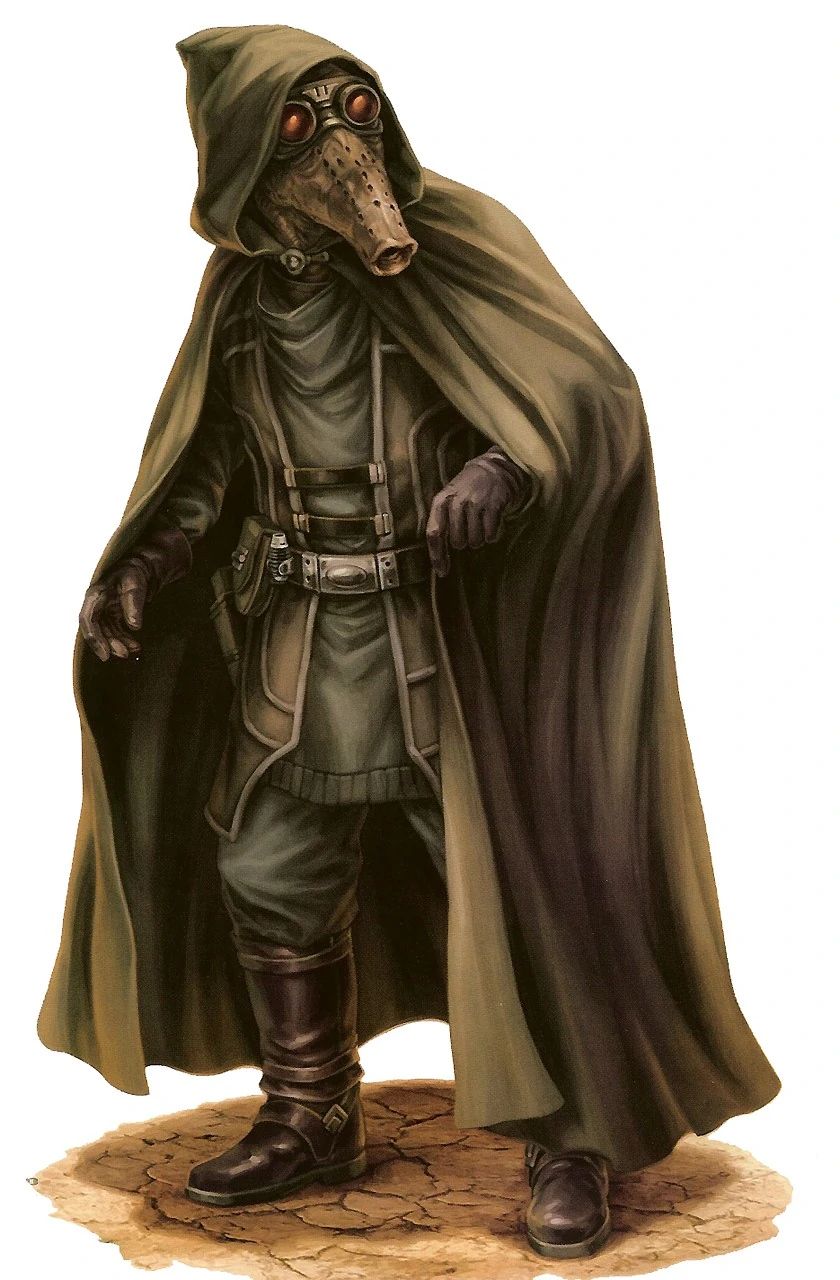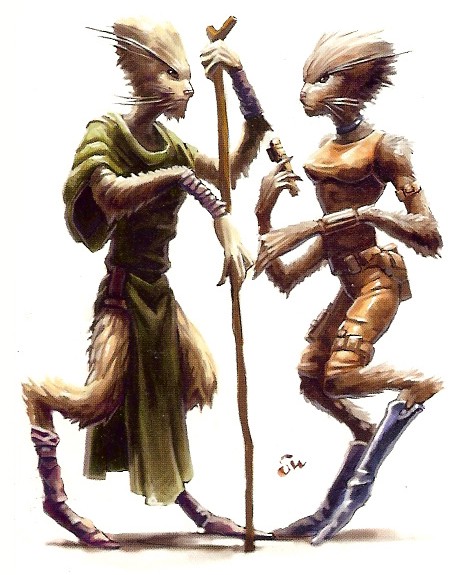 Name: Kubaz
Designation: Sentient
Classification: Mammalian
Average height: 1.7-2 meters
Skin color: Greenish-black
Hair color: Black
Distinctions: Prehensile snouts
Average lifespan: 81 years
Homeworld: Kubindi
Diet: Insects
Language: Kubazian
Attribute Dice: 12D
DEXTERITY 1D+2/3D+2
KNOWLEDGE 2D/4D+1
MECHANICAL 1D/3D+2
PERCEPTION 2D+2/4D+2
STRENGTH 1D/3D+2
TECHNICAL 2D/4D
Move: 8/10
Description: The Kubaz or Kubazian were an insectivorous species native to the planet Kubindi in the Outer Rim Territories. Although relatively new to the galactic community at the time of the institution of the Galactic Empire, the species was already ubiquitous throughout the Republic during the Great Galactic War and the Clone Wars.
Biology and appearance
A bipedal humanoid species of mammalian sentients, the Kubaz were distinctive for their short, prehensile facial snouts which were used for reaching insects within their hives. Having adapted to their sun-scorched, vegetation-deprived world, the Kubaz learned to survive off their world's native insect population. Filled with two rows of teeth for gnashing their food, the Kubaz trunk also functioned as a highly sensitive nose. Green-black skinned, Kubaz had short bristly hair growing from their heads and they stood upon two-toed feet. Having evolved on their homeworld of Kubindi, a planet which orbited a blue star, the Kubaz were highly sensitive to red wavelengths. When traveling to planets with a red or yellow star, the Kubaz were forced to don protective eye wear to avoid damaging their sensitive eyes.
Society and culture
The Kubazi society was based on a clan structure which dwelt in underground nests. Ruled by a queen, each clan took the name of their queen they were descended from. Developing a non-verbal language of hand gestures which indicated their intentions, Kubaz were able to speak Galactic Basic Standard, though with a strong nasally accent. When interacting with other species, some Kubaz would share certain hand signals with non-Kubaz in order to ease communications. Touching the nose, head, or shoulders could indicate intent, direction, and number. Obsessed with tact and decorum, the Kubaz place a high emphasis on the family unit and proper courtesies, displaying truthfulness to a fault. Valuing art and literature with such vigor as to sometimes practice smuggling of great works, the Kubaz did not find such pursuits to be wrong or unlawful.
Due to their habitual diet on Kubindi, the Kubaz had poor relations with other sentient insectile species such as the Geonosians.
History
Descended from insectivorous mammals, the Kubaz were native to the planet Kubindi, a world which suffered from intense solar flares from their planet's sun. The flares were so extreme much of Kubindi was scorched rock devoid of above-ground vegetation. As the Kubaz delved underground in search of insects to harvest, rival clans began raiding each others' insect farms. Erupting into the open conflict known as the Hive Wars, the bloody civil war was eventually resolved through the scientific advancements in the field of insecticulture. Altering the genetics of their insects to reproduce more rapidly and efficiently, the Kubaz also implemented a system of color-coding each clan's food supply differently so as to identify which bugs belong to which clan.
As war became a distant memory the Kubaz began to make great strides in the fields of science and spacecraft construction. Building starships which were restricted to their own local star system, the Kubaz were able to colonize three of the eleven worlds which orbited their local blue giant, Ku'Bakai. As colonies erupted on Ku'Bakai 11, 6 and 8, the Galactic Republic discovered the world and the Kubaz were able to move out of their home system by securing passage from paid transports. Not long after the Kubaz began to explore neighboring systems did they encounter the Verpine. Seeing them for insectoids and ignoring their sentience, the Kubaz were in danger of violating the rights of several insectoid species before the Republic intervened. Discouraging the race from developing hyperdrive technology, the Kubaz were forced to rely on visitors to take them to and from Kubindi.
Over the years, Kubaz gained a reputation as expert spies and slicers, and would sometimes work for criminal organizations. During the Cold War and later Great Galactic War, Kubaz were recruited by the Galactic Republic as intelligence operatives. During the Cold War, a band of Kubaz spies working for the Republic operated in the jungles of Dromund Kaas before being driven out by Imperial forces.
Enveloped in Hutt Space during the last decades of the Republic, the Kubaz were free from the oversight of the Galactic Senate for many years and became slightly more widespread, appearing as poachers on some worlds where insectoids were frequent. As the Clone Wars ground on in the greater galaxy, the Kubaz began to develop their own hyperdrive technology but were quickly sabotaged by Imperial agents when the Galactic Empire came to power. The Imperial propaganda machine quickly churned out false leads pointing to the Rebel Alliance as the true perpetrators of the attacks to discourage the race from looking to join their cause. Despite Imperial attempts some saw through the lies and joined the Alliance as spies or agents of espionage. Others joined the Empire and worked in crowded cities and ports, reporting to the local Imperial garrisons on the goings-on of local taverns and other breeding grounds for dissension and rebellion. During this era, the Kubaz established a colony on Doornik-319, which they named Morning's Bell.
Following the fall of the Empire, the Kubaz began talks with the New Republic but were invaded by the Yuuzhan Vong empire in 27 ABY. Despite being caught unawares, many Kubaz were able to evacuate their home system thanks to the efforts of the Jedi Knight Kyp Durron and his starfighter group. As the Yuuzhan Vong were responsible for exterminating nearly all life on Kubindi, the Kubaz who remained on the planet died of starvation. As the Yuuzhan Vong War saw its conclusion and the Galactic Alliance took to restoring the galaxy, the surviving Kubaz returned to their homeworld to begin the rebuilding process. Their species greatly diminished, the Kubaz were aided by the Hutt Empire and as of 127 ABY remained a part of the Hutt dependencies.
Kubaz in the galaxy
Many Kubaz abroad were spies sent to other worlds by their respective hives to learn about other worlds' politics, cultures, and cuisineā€”to the Kubaz, this would be native insects. Their taste for insects sometimes caused problems. Not recognizing insectoid beings as anything other than a food source, Kubaz would sometimes illegally purchase the bodies and body parts of sentient insectoid species. Spying, however, was not the only path Kubaz took, but rather they were a highly educated species that appreciated art, music, and literature. They were social beings that focused on mannerism and refinement and embraced traditions and history of their kind, so placing them under one occupation would not be representative of the species. A population of Kubaz was present on the planet Garnib.
Despite their finer points, some Kubaz were involved in the criminal underworld. A number of Kubaz joined the violent Black Heth criminal gang on Coruscant in the time prior to the Separatist Crisis. Later, during the Galactic Civil War, one Kubaz by the name of Garindan, a member of Zabin Hive, led stormtroopers to the droids C-3PO and R2-D2 while Jedi Master Obi-Wan Kenobi and Luke Skywalker tried to smuggle them off Tatooine. His close relative, Udin, was a bounty hunter, who later captured Luke Skywalker for the Empire, but accidentally turned him over to the Rebel Alliance.
While Force-sensitive Kubaz were exceedingly rare, one known member of the race was recorded as fighting in the New Sith Wars as a member of the Novitiate Sith. Named Glenk, the Sith was actually a spy for the Daimanate Sith and was quick to betray his assumed Master Odion at the Battle of Skarpos. No members of the Kubaz species were ever recorded as being inducted into the Jedi Order.
|












